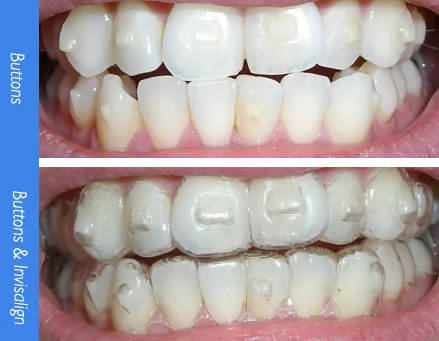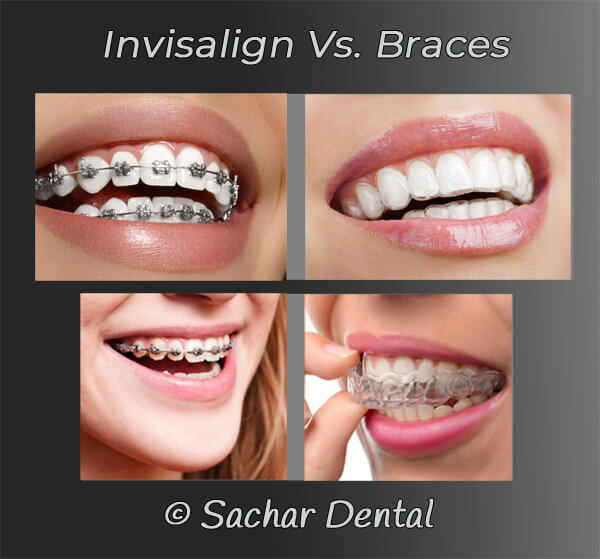Invisalign vs. Traditional Braces: Which Choice Is Right for You?
When considering orthodontic treatment, the choice in between Invisalign and typical braces provides several vital variables that merit cautious examination. Invisalign offers a discreet alternative with detachable aligners, while standard braces provide a much more visible yet efficient solution for extreme imbalance. Each alternative includes distinct advantages and disadvantages connected to appearances, comfort, treatment duration, and price. Comprehending these nuances is critical for making an informed decision that straightens with your personal preferences and way of living. The question continues to be: which choice will ideal meet your orthodontic demands and expectations?
Review of Treatment Choices

On the other hand, conventional dental braces include metal braces and cords that are bound to the teeth. This method applies continual stress over time to attain positioning. While efficient for intricate orthodontic issues, standard dental braces call for regular check outs for changes and can posture obstacles in keeping oral health due to the problem of cleaning around cords and braces.
Both alternatives have their advantages, and the choice frequently depends upon certain dental conditions, way of life preferences, and client conformity. Ultimately, consulting an orthodontic expert is important for identifying one of the most appropriate treatment plan tailored to individual requirements. Understanding the subtleties of each alternative can substantially influence the overall success of orthodontic therapy.
Visual Considerations
A considerable variable affecting the choice between Invisalign and traditional braces is the aesthetic appeal each therapy offers. Invisalign aligners are crafted from clear plastic, making them essentially invisible when used.
In comparison, conventional braces contain steel braces and cords, which can be extra noticeable. While improvements in orthodontic modern technology have actually resulted in the advancement of smaller braces and colored elastics, conventional braces still maintain an even more noticeable profile. For some people, the visibility of dental braces may hinder them from looking for essential treatment.
Inevitably, the choice between Invisalign and traditional braces may depend upon individual choices concerning aesthetics. Patients that focus on discretion typically lean towards Invisalign, while those that are less worried regarding exposure might opt for standard braces. Recognizing the aesthetic effects of each alternative is essential for making an educated choice that aligns with one's lifestyle and choices.
Comfort and Convenience

In terms of convenience, Invisalign aligners are removable, enabling clients to appreciate their preferred foods without limitation and maintain optimum oral hygiene. Brushing and flossing are simplified, as the aligners can be gotten throughout these regimens, whereas typical dental braces call for mindful navigating around braces and cords.
In comparison, conventional dental braces demand normal have a peek at this website modifications, making them less practical for those with busy routines. In general, the convenience and comfort of Invisalign make it an attractive selection for several individuals looking for orthodontic treatment.
Therapy Period and Effectiveness
While both Invisalign and typical braces are reliable in remedying oral imbalances, the period of therapy can differ substantially between the two options. Normally, Invisalign therapy can take anywhere from 12 to 18 months, relying on the complexity of the case. The clear aligners work by slowly shifting teeth right into their desired placements, and regular follow-ups with an orthodontist aid make sure progress stays on course.
In contrast, standard braces commonly need a longer dedication, usually varying from 18 months to three years. This results from their set nature and making use of cables and braces, which can be a lot more efficient for extreme imbalances and complicated instances (Invisalign). The therapy performance of standard dental braces is well-documented, as they enable precise adjustments and higher control over tooth activity
Ultimately, the option in between Invisalign and typical dental braces might depend upon both the anticipated therapy period and the specific oral issues handy. Consulting with an orthodontist is crucial, as they can give tailored recommendations based upon private needs, making certain the chosen method aligns with preferred durations and end results.
Cost Comparison and Insurance Coverage Options
Cost plays a significant role in the decision-making process for individuals taking into consideration orthodontic therapy, whether selecting Invisalign or traditional dental braces. On standard, the expense of Invisalign ranges from $3,000 to $8,000, while conventional braces typically cost between $2,000 and $6,000. Elements affecting these expenses consist of the complexity of the instance, the period of therapy, and geographical location.
Insurance coverage can considerably influence out-of-pocket costs. Many dental insurance coverage plans offer partial insurance coverage for orthodontic therapies, however the specifics can differ widely. It is crucial for people to review their insurance plan to identify the extent of protection for either choice. Typically, conventional braces may be extra frequently covered by insurance strategies compared to Invisalign, which some insurance companies classify as an aesthetic procedure.
Furthermore, numerous orthodontic methods supply adaptable layaway plan, making both therapy alternatives more accessible. Clients ought to ask about prospective funding choices and price cuts for ahead of time settlements. Reviewing the overall cost, including insurance benefits and layaway plan, is important great site for making an informed decision that straightens with both visual choices and spending plan factors to helpful resources consider.

Final Thought
In summary, the option in between Invisalign and traditional braces depends upon several factors, including aesthetic choices, convenience, therapy duration, and expense. Invisalign uses a discreet, removable alternative that promotes dental hygiene and nutritional adaptability, while typical braces might be better for intricate dental concerns and usually come with a lower price point. Eventually, examination with an orthodontist is vital to analyze private conditions and establish one of the most proper therapy option for attaining optimum dental alignment.
When taking into consideration orthodontic therapy, the choice between Invisalign and standard braces provides numerous vital elements that warrant cautious examination.Contrasting Invisalign and conventional braces discloses distinctive therapy choices for orthodontic correction.While both Invisalign and standard braces are efficient in correcting dental imbalances, the duration of therapy can vary significantly between the two options.Price plays a significant duty in the decision-making process for individuals considering orthodontic therapy, whether opting for Invisalign or traditional dental braces.In summary, the choice between Invisalign and typical dental braces hinges on several aspects, including aesthetic choices, convenience, therapy duration, and expense.
Comments on “Discover the Perks of Invisalign for a Perfect Smile Change”